Chiao Liu
Unlocking Visual Secrets: Inverting Features with Diffusion Priors for Image Reconstruction
Dec 11, 2024Abstract:Inverting visual representations within deep neural networks (DNNs) presents a challenging and important problem in the field of security and privacy for deep learning. The main goal is to invert the features of an unidentified target image generated by a pre-trained DNN, aiming to reconstruct the original image. Feature inversion holds particular significance in understanding the privacy leakage inherent in contemporary split DNN execution techniques, as well as in various applications based on the extracted DNN features. In this paper, we explore the use of diffusion models, a promising technique for image synthesis, to enhance feature inversion quality. We also investigate the potential of incorporating alternative forms of prior knowledge, such as textual prompts and cross-frame temporal correlations, to further improve the quality of inverted features. Our findings reveal that diffusion models can effectively leverage hidden information from the DNN features, resulting in superior reconstruction performance compared to previous methods. This research offers valuable insights into how diffusion models can enhance privacy and security within applications that are reliant on DNN features.
GazeGen: Gaze-Driven User Interaction for Visual Content Generation
Nov 07, 2024
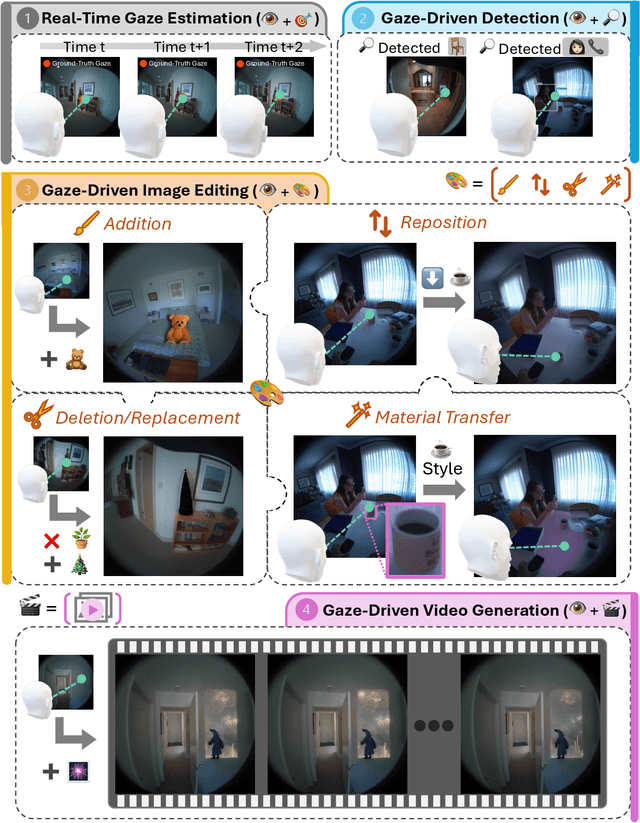

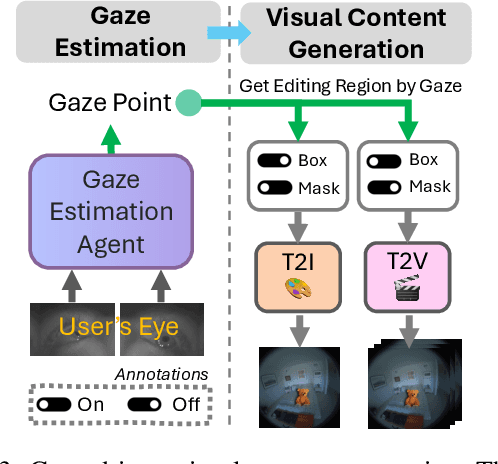
Abstract:We present GazeGen, a user interaction system that generates visual content (images and videos) for locations indicated by the user's eye gaze. GazeGen allows intuitive manipulation of visual content by targeting regions of interest with gaze. Using advanced techniques in object detection and generative AI, GazeGen performs gaze-controlled image adding/deleting, repositioning, and surface material changes of image objects, and converts static images into videos. Central to GazeGen is the DFT Gaze (Distilled and Fine-Tuned Gaze) agent, an ultra-lightweight model with only 281K parameters, performing accurate real-time gaze predictions tailored to individual users' eyes on small edge devices. GazeGen is the first system to combine visual content generation with real-time gaze estimation, made possible exclusively by DFT Gaze. This real-time gaze estimation enables various visual content generation tasks, all controlled by the user's gaze. The input for DFT Gaze is the user's eye images, while the inputs for visual content generation are the user's view and the predicted gaze point from DFT Gaze. To achieve efficient gaze predictions, we derive the small model from a large model (10x larger) via novel knowledge distillation and personal adaptation techniques. We integrate knowledge distillation with a masked autoencoder, developing a compact yet powerful gaze estimation model. This model is further fine-tuned with Adapters, enabling highly accurate and personalized gaze predictions with minimal user input. DFT Gaze ensures low-latency and precise gaze tracking, supporting a wide range of gaze-driven tasks. We validate the performance of DFT Gaze on AEA and OpenEDS2020 benchmarks, demonstrating low angular gaze error and low latency on the edge device (Raspberry Pi 4). Furthermore, we describe applications of GazeGen, illustrating its versatility and effectiveness in various usage scenarios.
Neural Architecture Search of Hybrid Models for NPU-CIM Heterogeneous AR/VR Devices
Oct 10, 2024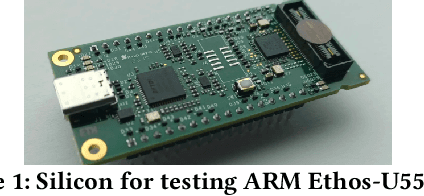
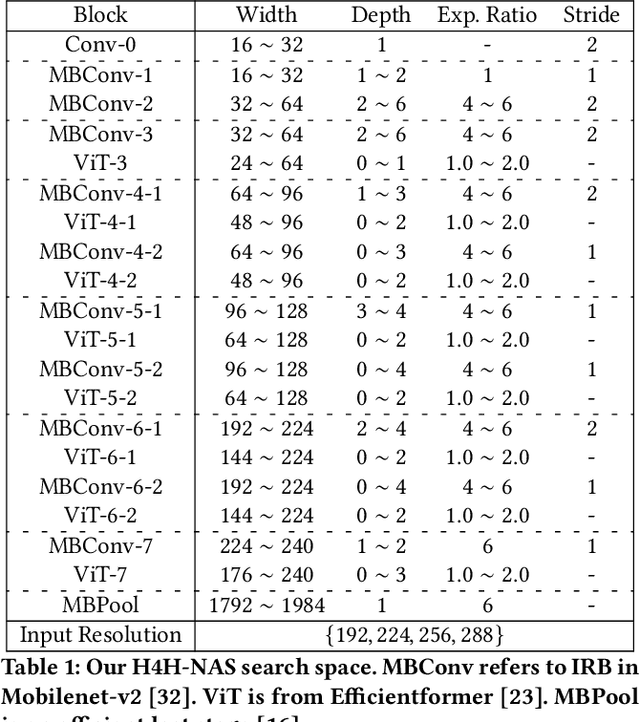

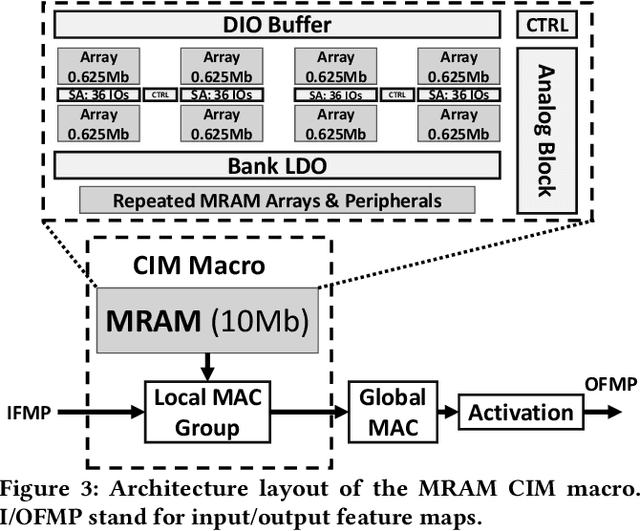
Abstract:Low-Latency and Low-Power Edge AI is essential for Virtual Reality and Augmented Reality applications. Recent advances show that hybrid models, combining convolution layers (CNN) and transformers (ViT), often achieve superior accuracy/performance tradeoff on various computer vision and machine learning (ML) tasks. However, hybrid ML models can pose system challenges for latency and energy-efficiency due to their diverse nature in dataflow and memory access patterns. In this work, we leverage the architecture heterogeneity from Neural Processing Units (NPU) and Compute-In-Memory (CIM) and perform diverse execution schemas to efficiently execute these hybrid models. We also introduce H4H-NAS, a Neural Architecture Search framework to design efficient hybrid CNN/ViT models for heterogeneous edge systems with both NPU and CIM. Our H4H-NAS approach is powered by a performance estimator built with NPU performance results measured on real silicon, and CIM performance based on industry IPs. H4H-NAS searches hybrid CNN/ViT models with fine granularity and achieves significant (up to 1.34%) top-1 accuracy improvement on ImageNet dataset. Moreover, results from our Algo/HW co-design reveal up to 56.08% overall latency and 41.72% energy improvements by introducing such heterogeneous computing over baseline solutions. The framework guides the design of hybrid network architectures and system architectures of NPU+CIM heterogeneous systems.
SplitNets: Designing Neural Architectures for Efficient Distributed Computing on Head-Mounted Systems
Apr 10, 2022
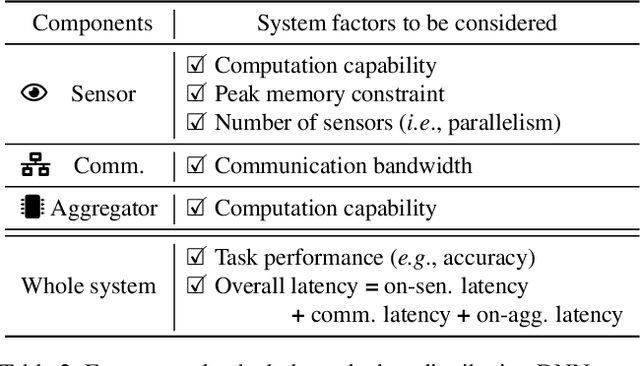
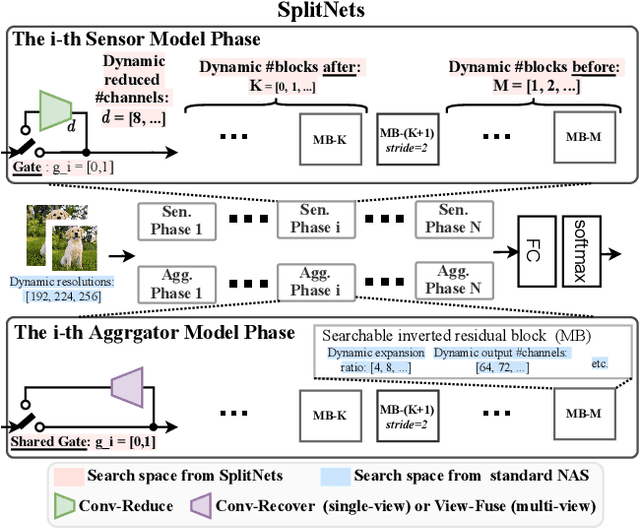

Abstract:We design deep neural networks (DNNs) and corresponding networks' splittings to distribute DNNs' workload to camera sensors and a centralized aggregator on head mounted devices to meet system performance targets in inference accuracy and latency under the given hardware resource constraints. To achieve an optimal balance among computation, communication, and performance, a split-aware neural architecture search framework, SplitNets, is introduced to conduct model designing, splitting, and communication reduction simultaneously. We further extend the framework to multi-view systems for learning to fuse inputs from multiple camera sensors with optimal performance and systemic efficiency. We validate SplitNets for single-view system on ImageNet as well as multi-view system on 3D classification, and show that the SplitNets framework achieves state-of-the-art (SOTA) performance and system latency compared with existing approaches.
Distributed On-Sensor Compute System for AR/VR Devices: A Semi-Analytical Simulation Framework for Power Estimation
Mar 14, 2022
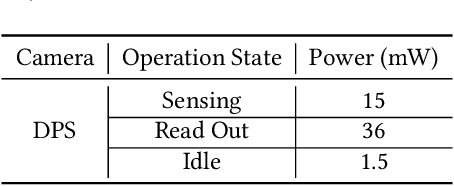


Abstract:Augmented Reality/Virtual Reality (AR/VR) glasses are widely foreseen as the next generation computing platform. AR/VR glasses are a complex "system of systems" which must satisfy stringent form factor, computing-, power- and thermal- requirements. In this paper, we will show that a novel distributed on-sensor compute architecture, coupled with new semiconductor technologies (such as dense 3D-IC interconnects and Spin-Transfer Torque Magneto Random Access Memory, STT-MRAM) and, most importantly, a full hardware-software co-optimization are the solutions to achieve attractive and socially acceptable AR/VR glasses. To this end, we developed a semi-analytical simulation framework to estimate the power consumption of novel AR/VR distributed on-sensor computing architectures. The model allows the optimization of the main technological features of the system modules, as well as the computer-vision algorithm partition strategy across the distributed compute architecture. We show that, in the case of the compute-intensive machine learning based Hand Tracking algorithm, the distributed on-sensor compute architecture can reduce the system power consumption compared to a centralized system, with the additional benefits in terms of latency and privacy.
Going Deeper in Spiking Neural Networks: VGG and Residual Architectures
Jun 09, 2018



Abstract:Over the past few years, Spiking Neural Networks (SNNs) have become popular as a possible pathway to enable low-power event-driven neuromorphic hardware. However, their application in machine learning have largely been limited to very shallow neural network architectures for simple problems. In this paper, we propose a novel algorithmic technique for generating an SNN with a deep architecture, and demonstrate its effectiveness on complex visual recognition problems such as CIFAR-10 and ImageNet. Our technique applies to both VGG and Residual network architectures, with significantly better accuracy than the state-of-the-art. Finally, we present analysis of the sparse event-driven computations to demonstrate reduced hardware overhead when operating in the spiking domain.
 Add to Chrome
Add to Chrome Add to Firefox
Add to Firefox Add to Edge
Add to Edge